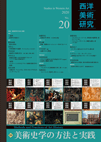|
mArticle Abstractsn
Special Issue
Foreword
Atushi Miura
Celebrating the 20th Issue of Studies in Western Art
Articles
Shigeki Abe
Style and History
Works of art and other forms created by human hands have a style. Therefore, style has received much attention and research in art history and cultural anthropology. It can be divided into two major directions: those that aim at the classification of styles and those that trace the transition of styles. In this article, I will review each of these two directions after confirming the characteristics of the styles. It will reconsider the conventional image of gstylistic historyh, which consists of the alternation of styles specific to each period.
Motokazu Kimata
Development of Medieval Iconography: From Didron to Schapiro
This paper reviews the methodological development of medieval iconography, from the latter half of the 19th century to the latter half of the 20th century, by major researchers such as Didron, Male, Warburg, Focillon, Reau, Panofsky and Schapiro, focusing on the challenges that attracted their attention of clarifying the historical relationship between form and meaning. Through this perspective, I would like to shed light on the hidden relationships between researchers and methodological explorations that have received little attention in the past.
Kayo Hirakawa
Art and Society in the Early Modern Era: Workshop, Guild, Market, and Politics
Thinking about artworks in the social context where they were produced and appreciated is already an established method in art history. This research method of the so-called gsocial history of arth is, however, relatively new and has rapidly developed since the 1950s. This paper examines important studies on the gsocial history of arth in German art and considers further possibilities for this method.
Masayuki Tanaka
Socio-historical Approaches to Modern Art: Beyond Theories of Context and Reflection
This article surveys the development of socio-historical approaches to modern art. Social art history first developed in the 1930s and then further evolved in the 1970s. However, new studies that appeared in the 70s were different from the earlier ones in that they criticized the context and reflection theory on which earlier scholars had been dependent. Paying more attention to the gnegotiationsh and/or gtransactionsh between art works and society, scholars in the 1970s pursued a dialectical approach of analyzing how society and works of art are related.
Atsushi Miura
Meyer Schapiro and the Development of French Avant-Garde Art History
American art historian Meyer Shapiro has applied methodological stimuli such as semiotics, psychoanalysis, and social history to art studies from an early stage. Shapiro's practice found successors in the theory-oriented Hubert Damisch, as well as the French translators of Shapiro's articles, J.-C. Lebensztejn and Daniel Arras. The intellectual avant-garde of France, which practiced image research differently from traditional art history, is sensitive to the peculiarity of art works and the impossibility of representation. Its members are attracted to the deviations and mutations of images, deepening the method of analysis.
Mari Komoto
The Interface of Art History, Feminism, and Postcolonialism
Feminism and postcolonialism can theoretically be parallel, and even intersectional, on issues of race, class, and gender; both approaches analyze gender or colonial oppression from an interdisciplinary viewpoint to oppose such oppression. Art history from a feminist/postcolonial perspective, a relatively recent phenomenon in this discipline, proposes to change radically the paradigm of masculinist/Eurocentric art history itself. This paper outlines the intersecting history of feminist and postcolonial art history, to reexamine the validity and limits of their various methodologies.
Tetsuhiro Kato
History of Art History, Its Purposes and Issues
The aim of this paper is to make clear the current significance and potential of the study of art historiography. After reviewing the birth and the development of gthe history of art historyh, it examines the three types of art historiography according to their roles: the support of institutions; the education of beginners; and critical reflection on institutional framing. Contemporary art historiography presents itself as a more post-modern discipline, and is presented with three new, important tasks: the de-aestheticization of art; globalization; and the introduction of vanguard technology.
State of Research
Akira Akiyama
Notes on the Agency of the Idol / Sacred Image
Bibliography
Edited by Kayo Hirakawa
The Others
Articles
Shigetoshi Osano, The Term Capsa in the History of Italian Art: The Transformation of Its Meaning and Function
The present paper aims to shed light on the significant transformation of the meaning and function of the Latin capsa in an art-historical context in Italy, with particular reference to literary documents and artworks. The term, which originally designated a box or chest or holder, sequentially added new meanings such as reliquary (from the 5 th century onward) and eventually served as a synonym for tabernacle (well before the 12 th century). Throughout the centuries, the original meaning and function of the term was retained in its capacity as a chest holding a small-sized portrait or other precious objects. In the meantime, its reference to a tabernacle began to be used for late medieval sculptures of the Virgin Mary, as well as painted altarpieces that were opened and closed during religious rites such as the veiling of all church images during Lent.
Exhibition and Exhibition Catalogue Reviews
Akihito Ozaki
Vermeer and the Masters of Genre Painting: Inspiration and Rivalry (Paris/Dublin/Washington 2017-2018)
Akihiro Ozaki
Rubens: The Power of Transformation (Vienna/Frankfurt 2017-2018)
Tatsuya Saito
Frederic Bazille (1841-1870). La jeunesse de l'impressionnisme (Grenoble/Paris, 2016-2017) ; Fantin-Latour. A fleur de peau (Montpellier/Paris/Washington, D.C., 2016-2017)
Report
Haruko Hirota
Report of the Gauguin Exhibition at the Grand Palais in Paris and the Colloquium
Essay
Madeline H. Caviness, A Twentieth-Century Miracle of Thomas Becket ?
Translation and Commentary by Izumi Florence Ota
Remembrance
Shigetoshi Osano, In Memory of the Late Toshiharu Nakamura, a Colleague and Ally Since the First Issue
A Message from the Editorial Board: On the Occasion of the Publication of Issue 20
|
